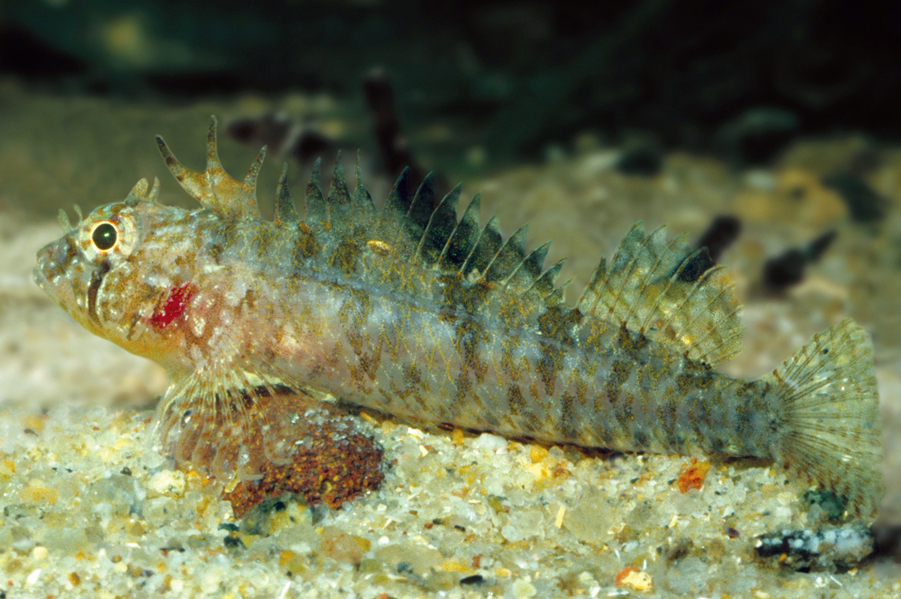Notched Threefin, Trinorfolkia incisa (Kuiter 1986)
Other Names: Notched Triplefin

A Notched Threefin, Trinorfolkia incisa, in Port Phillip, Victoria. Source: Rudie H. Kuiter / Aquatic Photographics. License: All rights reserved
Summary:
A greyish to brown triplefin with 6-7 darker bars along the back and side, dark spots along the anal-fin base, a relatively narrow dark bar beneath the eye, a pale to dusky first dorsal fin, a transparent to dusky second dorsal fin, and narrow diagonal stripes on the third dorsal and anal fins.
The spinous dorsal fin is deeply incised dorsal-fin membranes, and very large pectoral fins with the middle rays extending almost to below the rear of the second dorsal fin. The posterior nostril is large, tubular, and equal or greater in height to tits diameter, and a rounded to multi-lobed fleshy tentacle above the eye.
The spinous dorsal fin is deeply incised dorsal-fin membranes, and very large pectoral fins with the middle rays extending almost to below the rear of the second dorsal fin. The posterior nostril is large, tubular, and equal or greater in height to tits diameter, and a rounded to multi-lobed fleshy tentacle above the eye.
Cite this page as:
Bray, D.J. 2020, Trinorfolkia incisa in Fishes of Australia, accessed 28 Jun 2025, https://fishesofaustralia.net.au/home/species/31
Notched Threefin, Trinorfolkia incisa (Kuiter 1986)
More Info
|
Distribution |
Endemic to southern Australia, from Wilsons Promontory, Victoria, to Rottnest Island, Western Australia. Inhabits ledges and caves on shallow rocky reefs at depths to 30 m. The species may be more common on offshore reefs. |
|
Features |
Dorsal fin III + XI-XIV + 7-10; Anal fin II,15-19; Caudal fin 13; Pectoral fin 15-16; Pelvic fin II,2; Lateral line scales, upper row 19-25, lower row 8-13. Body depth 18-21% SL; eye diameter about 40% HL; fleshy tentacle above eye large, rounded to multilobate; posterior nostril large, raised; anterior nostril tubular with a leafy tentacle. Head pores large, numerous. Scales absent from pectoral-fin base and a small area on belly behind pelvic fins. Lateral line in two parts, upper section extending to below third dorsal fin. First dorsal fin equal to or slightly taller than second fin; third dorsal fin with simple or branched rays; pectoral fin large, middle rays extending almost to rear of second dorsal fin. |
|
Etymology |
The specific name is from the Latin incisus (= cut up, dissected, bearing cuts) in reference to the “deeply incised” membranes of the first dorsal fin. |
|
Species Citation |
Norfolkia incisa Kuiter 1986, Revue Française d'Aquariologie et Herpétologie 12(3): 93, figs 6-7. Type locality: Portsea, Port Phillip Bay, Victoria, depth 3 m. |
|
Author |
Bray, D.J. 2020 |
|
Resources |
Notched Threefin, Trinorfolkia incisa (Kuiter 1986)
References
Fricke, R. 1994. Tripterygiid fishes of Australia, New Zealand and the Southwest Pacific Ocean, with descriptions of 2 new genera and 16 species (Teleostei). Theses Zoologicae 24: 1-585 figs 1-130
Fricke, R. 1997. Tripterygiid fishes of the western and central Pacific, with descriptions of 15 new species, including an annotated checklist of world Tripterygiidae (Teleostei). Theses Zoologicae 31: 1-607
Gomon, M.F. 2008. Family Tripterygiidae. pp. 684-693 in Gomon, M.F., Bray, D.J. & Kuiter, R.H. (eds). Fishes of Australia's Southern Coast. Sydney : Reed New Holland 928 pp.
Hoschke, A., Whisson, G. & Moore, G.I. 2019. Complete list of fishes from Rottnest Island. pp. 150-161 in Whisson, G. & Hoschke, A. (eds) The Rottnest Island fish book. 2nd ed. Perth : Aqua Research and Monitoring Services.
Kuiter, R.H. 1986. A new genus and three new species of tripterygiid fishes of Australia's south coast. Revue Française d'Aquariologie et Herpétologie 12(3): 89-96 9 figs
Kuiter, R.H. 1993. Coastal Fishes of South-eastern Australia. Bathurst : Crawford House Press 437 pp.
Kuiter, R.H. 1994. Families Blenniidae and Tripterygiidae. pp. 728-740 in Gomon, M.F., Glover, C.J.M. & Kuiter, R.H. (eds). The Fishes of Australia's South Coast. Adelaide : State Printer 992 pp. 810 figs.
Kuiter, R. & Kuiter, S. 2018. Coastal sea-fishes of south-eastern Australia. Seaford, Victoria : Aquatic Photographics, 371 pp.
Williams, J. & Holleman, W. 2014. Trinorfolkia incisa. The IUCN Red List of Threatened Species 2014: e.T179084A1567788. https://dx.doi.org/10.2305/IUCN.UK.2014-3.RLTS.T179084A1567788.en. Downloaded on 01 December 2020.



